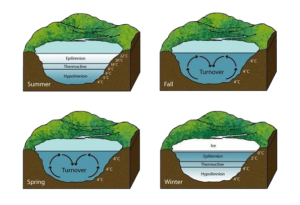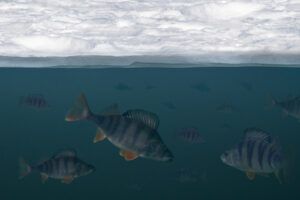
12 Feb A Look Under The Ice: The Winter Pond
Ponds and lakes are continually changing with every season and winter is no exception. But what actually occurs in the water? In order to answer this question, one must first understand the relationship between water density and temperature.
 Density and Temperature
Density and Temperature
Throughout the beginning of summer, higher temperatures and sunlight begin to warm the water. When this happens, the less dense warmer water rises to the top, while the denser colder water sinks to the bottom, creating a barrier between the two. This is known as thermal stratification. This same process occurs during the winter, but in a slightly different way. During the fall, the outside temperature drops and begins to cool the surface of the water. As the surface water cools, it becomes more dense than the warmer water below. Eventually this cooler surface water will sink to the bottom and push relatively warmer water to the surface. This cycle is known as turnover. This process also re-oxygenates the entire water column.
Why does ice not sink then since colder water is denser?
Although cold water is normally denser, it reaches its maximum density at 39.2 degrees Fahrenheit. This means any water colder than that is less dense and will rise to the surface. This phenomenon allows ice to form and float on the surface of the water. If the opposite were true, ice would continually form and sink to the bottom until the entire pond was one big ice block. In this case, nothing in the pond would be able to survive.
How do fish survive during the winter?
Fish use oxygen in order to survive. During the long winter months, oxygen levels can drop dramatically. This happens because ice prevents oxygen in the air to mix with the water. In addition, snow covered ice can block out sunlight that is necessary for aquatic plants and phytoplankton to produce oxygen. In order to survive, fish have to adapt to their surroundings. Fish are cold blooded, which allows them to match the temperature of their environment. Fish slow their metabolism in order to use less oxygen. This means reducing their respiration, digestion, and activitylevel. Likewise, other organisms such as amphibians and insects slow down and become dormant during the winter.

Will weeds and algae die during the winter?
Algae and weeds use photosynthesis in order to convert sunlight into energy. This process absorbs carbon dioxide and releases oxygen. Ice prevents light from reaching algae and weeds, which in turn decreases photosynthesis and causes them to die or go dormant. Many submersed weeds will die but their root systems will stay intact and store energy for the spring. When spring arrives and the light returns, algae and submersed weeds will begin to grow again.
